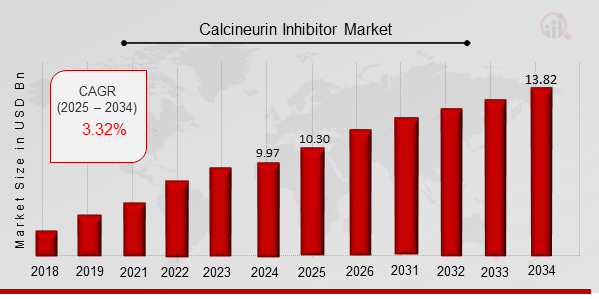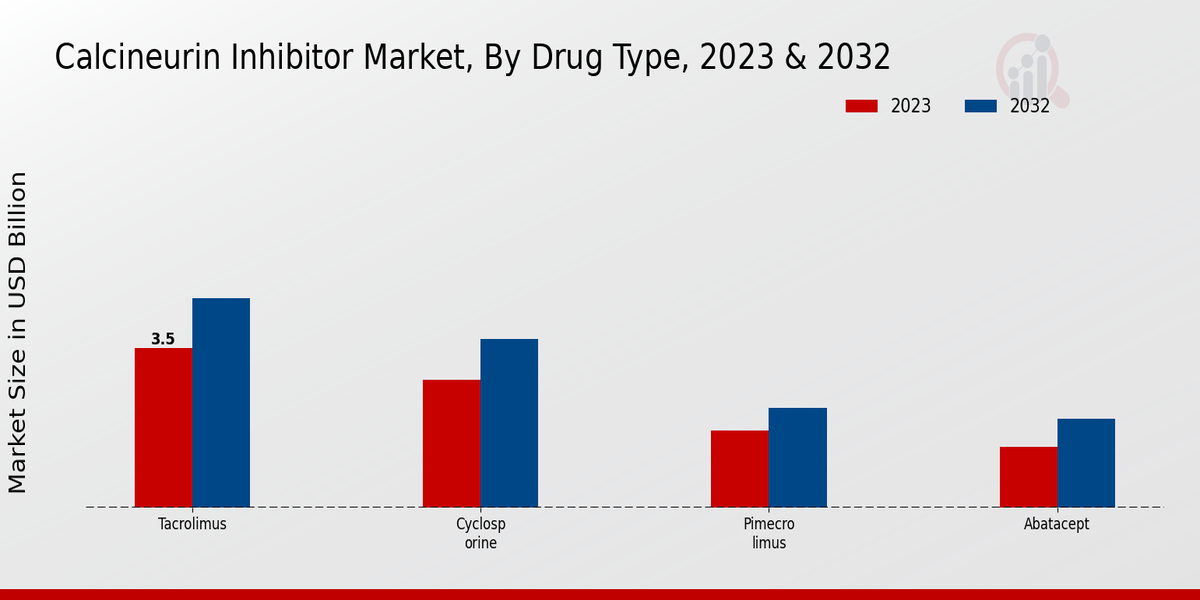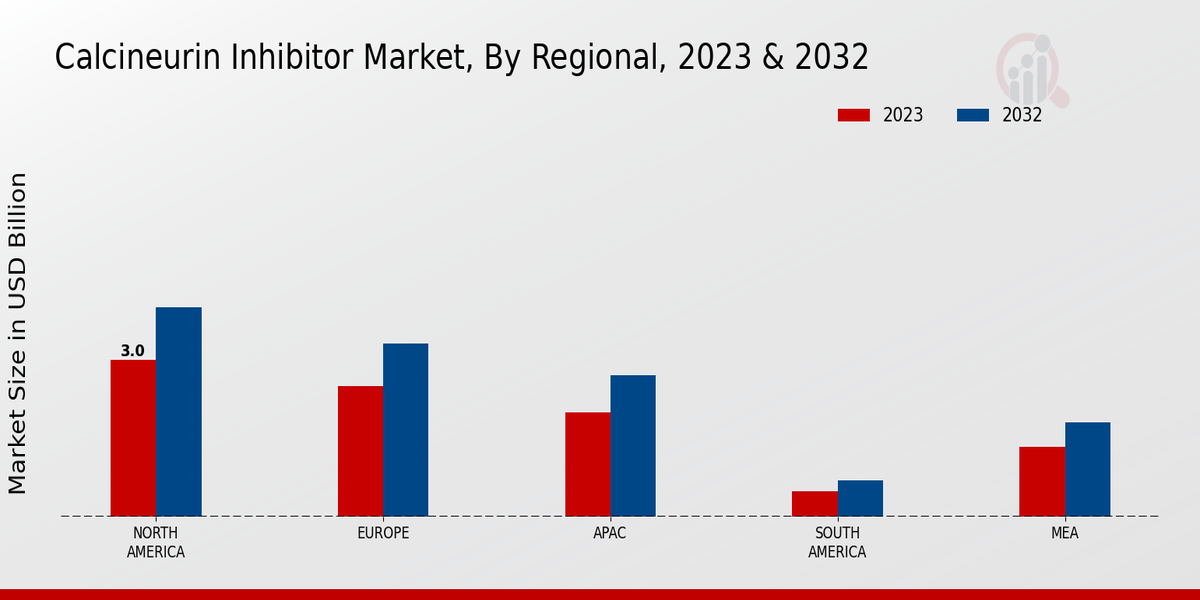Global Calcineurin Inhibitor Market Overview
As per MRFR analysis, the Calcineurin Inhibitor Market Size was estimated at 9.97 (USD Billion) in 2024. The Calcineurin Inhibitor Market Industry is expected to grow from 10.30 (USD Billion) in 2025 to 13.82 (USD Billion) till 2034, at a CAGR (growth rate) is expected to be around 3.32% during the forecast period (2025 - 2034).
Key Calcineurin Inhibitor Market Trends Highlighted
Several key trends are visible in the Global Calcineurin Inhibitor Market that are likely to define its future. One such important driver is the rising number of autoimmune diseases and organ transplant procedures, which in turn has enhanced the need for efficient immunosuppressive therapies. The search for solutions that lessen the chance of an organ being rejected continues among health providers. Advances in drug development and drug delivery systems have also improved treatment responses and patient adherence. There is an increase demand for more specific treatments due to the growing importance of targeted medicine which is in turn aiding the expansion of the market further.
The opportunities in this market are many. The focus of the ongoing R&D programs is to identify calcineurin inhibitors with new indications. Such innovations may include new treatment indications in other disease conditions such as organ transplants and autoimmune diseases, thus creating avenues for growth. Also, due to an increase in healthcare spending and improvement of the understanding of the modern health treatment possibilities, new markets provide great prospects. Such collaborations between pharmaceutical companies and research institutions can also assist in identifying better calcineurin inhibitors that will satisfy the unmet medical needs of the populace.
Recently, a trend has emerged towards the combination of calcineurin inhibitors with other immunosuppressants in order to improve treatment outcomes without increasing toxicity. Drug repositioning is also an emerging trend where calcineurin inhibitors are used for new indications. There are also some digital health interventions which may change the ways patients are managed in terms of treatment response and adherence. There is also an increasing interest in the development of biosimilars in the calcineurin inhibitor space as regulatory requirements are changing which would provide more affordable therapeutic options.
Such a vivid picture suggests that the Global Calcineurin Inhibitor Market will grow further, sustained by novel approaches and wider recognition of the utility of these inhibitors in an increasing number of therapeutic areas.

Source: Primary Research, Secondary Research, MRFR Database and Analyst Review
Calcineurin Inhibitor Market Drivers
Increasing Prevalence of Autoimmune Diseases
The Global Calcineurin Inhibitor Market Industry is significantly driven by the rising incidence of autoimmune diseases, which have become a major global health concern in recent years. The prevalence of conditions such as rheumatoid arthritis, lupus, and psoriasis has been on the rise, leading to an increased demand for effective treatment options. Calcineurin inhibitors, which are known for their immunosuppressive properties, are widely used in the management of these autoimmune disorders.As the global population ages and lifestyle factors contribute to the acceleration of such diseases, the need for these therapeutic drugs has surged notably. The increasing awareness among patients regarding treatment options and the growing number of healthcare facilities providing advanced healthcare services further compound this scenario, driving market growth. Moreover, continued research and development in the field of immunology will likely lead to enhanced formulations of calcineurin inhibitors that are more effective and come with fewer side effects, making them a preferred choice for treating complex disorders.As healthcare professionals continue to push for innovative solutions to tackle chronic health issues, the Global Calcineurin Inhibitor Market Industry is poised for sustained growth driven by the relentless quest for effective disease management therapies.
Advancements in Pharmaceutical Research
The ongoing advancements in pharmaceutical research significantly contribute to the growth of the Global Calcineurin Inhibitor Market Industry. Innovations in drug formulation and delivery systems have opened new avenues for calcineurin inhibitors, enhancing their efficacy and reducing side effects. Pharmaceutical companies are investing in developing new molecules and combination therapies that utilize calcineurin inhibitors in more efficient ways.This not only broadens the scope of treatment but also caters to a wider patient demographic. The drive towards personalized medicine is another pivotal factor, as it aligns with the need for more tailored therapeutic strategies, ultimately boosting market demand.
Rising Awareness and Adoption of Immunosuppressive Therapies
The growing awareness and acceptance of immunosuppressive therapies among both healthcare professionals and patients is a prominent driver of the Global Calcineurin Inhibitor Market Industry. More patients are increasingly educated about their treatment options and the benefits that calcineurin inhibitors offer, resulting in a higher rate of adoption. Additionally, healthcare providers are recommending these therapies more frequently, recognizing their efficacy in managing various conditions.As the understanding of immunology expands, the reliance on immunosuppressive treatments is expected to rise, propelling the growth of the market forward.
Calcineurin Inhibitor Market Segment Insights
Calcineurin Inhibitor Market Drug Type Insights
The Global Calcineurin Inhibitor Market is segmented by drug type, comprising Tacrolimus, Cyclosporine, Pimecrolimus, and Abatacept. In 2023, the overall market is valued at 9.34 USD Billion, with Tacrolimus emerging as a dominating force, holding a significant share valued at 3.5 USD Billion, which reflects its efficacy in treating organ transplant rejection and autoimmune diseases. Following closely is Cyclosporine, valued at 2.8 USD Billion in the same year; this drug maintains its relevance due to its established role in immunosuppression protocols.Pimecrolimus, with a value of 1.7 USD Billion, is significant for its specific application in dermatology, providing targeted treatment for eczema and thus appealing to a distinct patient demographic. Abatacept, valued at 1.34 USD Billion, while the smallest in terms of market value, is still crucial for conditions such as rheumatoid arthritis, showing its relevance in chronic conditions requiring long-term management. Overall, the Global Calcineurin Inhibitor Market showcases diverse therapeutic applications across these drug types, driving growth in the market.The increasing prevalence of autoimmune diseases and organ transplants serves as a primary driver for this segment, promoting further advancements in the formulation and accessibility of these drugs. Despite the notable growth opportunities, challenges such as side effects and drug interactions can impact patient adherence to treatments, necessitating ongoing research and development. The Global Calcineurin Inhibitor Market statistics reveal that each drug type plays a unique role, contributing distinctly to the overall market revenue and shaping the landscape of therapeutic options in this field.With a strong market foundation, the segment is poised for continued expansion as healthcare systems aim to enhance treatment options for complex disorders through these essential calcineurin inhibitors.

Source: Primary Research, Secondary Research, MRFR Database and Analyst Review
Calcineurin Inhibitor Market Route of Administration Insights
The Global Calcineurin Inhibitor Market, with an expected valuation of 9.34 USD billion in 2023, features a diverse Route of Administration that plays a vital role in its dynamics. This segment is essential as it determines the efficacy and convenience of drug delivery in treatment protocols. Various methods such as Oral, Intravenous, and Topical administration are prevalent, each catering to specific patient needs and therapeutic scenarios. Oral administration is often favored for its ease and compliance, which significantly aids in treatment adherence, while Intravenous methods are crucial for rapid onset of action in acute situations.Topical administration has gained attention for localized treatment, minimizing systemic exposure and enhancing patient safety. The differentiation in these routes reflects the Global Calcineurin Inhibitor Market segmentation and influences overall market growth. With increasing patient population and evolving healthcare infrastructures, there exists ample opportunity for innovation in drug formulations and delivery mechanisms, ultimately supporting the Global Calcineurin Inhibitor Market industry. Market trends indicate a continuous shift toward more patient-centered treatment options, and understanding these routes not only provides insights into preferences but also highlights the critical aspects of treatment effectiveness across various demographics.
Calcineurin Inhibitor Market Therapeutic Application Insights
The Global Calcineurin Inhibitor Market within the Therapeutic Application segment is projected to experience notable growth, valued at 9.34 USD Billion in 2023, and is poised for significant expansion by 2032. This segment covers a variety of applications including Organ Transplantation, Autoimmune Diseases, Dermatology, and Cardiology. Among these, Organ Transplantation holds a significant place as calcineurin inhibitors are crucial for preventing organ rejection, thereby driving demand in this area. Autoimmune Diseases represent another important facet, as these disorders often necessitate immunosuppressive therapies that rely on calcineurin inhibitors, creating a robust market opportunity.Dermatology also plays a key role, given that these drugs are prescribed for severe skin conditions such as psoriasis and eczema. Lastly, Cardiology is increasingly recognizing the importance of calcineurin inhibitors in managing certain cardiac conditions, which supports the overall growth trend. The Global Calcineurin Inhibitor Market data reflect rising investment in research and development, paving the way for innovative therapeutic options and broader applications, while market growth is also influenced by escalating incidences of organ transplants and autoimmune disorders.Overall, the Global Calcineurin Inhibitor Market industry is experiencing dynamic changes driven by these therapeutic applications, underscoring the importance of advancing treatment options.
Calcineurin Inhibitor Market End User Insights
The Global Calcineurin Inhibitor Market, valued at 9.34 USD Billion in 2023, showcases diverse end user applications. Hospitals play a crucial role in this market, providing specialized care and advanced treatments for various conditions, thereby being a significant contributor to the overall market revenue. Homecare settings are gaining traction due to the increasing demand for personalized care, enabling patients to manage their conditions in a comfortable environment. Pharmacies represent another vital segment, facilitating easy access to calcineurin inhibitors, thus ensuring that patients adhere to their prescribed treatment regimens.The distribution among these segments highlights the evolving nature of healthcare, as preferences shift towards more convenient and accessible treatment options. Overall, market growth can be attributed to factors such as an aging population, rising incidence of chronic diseases, and advancements in therapeutic approaches, further emphasizing the importance of each end user category in the Global Calcineurin Inhibitor Market industry. The market is projected to grow at a steady rate, reflecting changing dynamics in healthcare delivery and patient care preferences.
Calcineurin Inhibitor Market Regional Insights
The Global Calcineurin Inhibitor Market revenue highlights significant regional dynamics, with North America leading the way. In 2023, North America accounted for 3.0 USD Billion, projected to grow to 4.0 USD Billion by 2032, representing a major portion of the market. Europe follows closely with a notable valuation of 2.5 USD Billion in 2023 and is expected to reach 3.3 USD Billion in 2032, indicating substantial demand in this region. The APAC region, valued at 2.0 USD Billion in 2023 and anticipated to reach 2.7 USD Billion by 2032, reflects growing healthcare investment and increasing chronic disease prevalence.South America, though smaller with a valuation of 0.5 USD Billion in 2023 and projected growth to 0.7 USD Billion, shows potential market development opportunities. Meanwhile, the MEA region stands at 1.34 USD Billion in 2023 and is expected to reach 1.8 USD Billion by 2032, driven by expanding healthcare infrastructure. The diverse growth across these regions underscores the Global Calcineurin Inhibitor Market segmentation's relevance, as demand is influenced by regional healthcare policies, economic factors, and disease burden across populations.

Source: Primary Research, Secondary Research, MRFR Database and Analyst Review
Calcineurin Inhibitor Market Key Players and Competitive Insights:
The Global Calcineurin Inhibitor Market has been characterized by significant advancements in immunosuppressive therapies, primarily targeting conditions such as organ transplant rejection and autoimmune diseases. As the demand for effective treatment options rises, the competitive landscape continually evolves, with numerous pharmaceutical companies leveraging their research and development capabilities to enhance their product offerings. Key players are investing substantially in clinical trials and innovative drug formulations to gain a foothold in this niche market. Additionally, collaborations and strategic partnerships further influence market dynamics, allowing for shared expertise and technology transfer, which, in turn, enables companies to address patient needs more effectively and improve healthcare outcomes across diverse demographics.AstraZeneca has established a strong presence in the Global Calcineurin Inhibitor Market with its strategic focus on innovative drug development and robust clinical research pipeline. The company benefits from its extensive portfolio, highlighting its commitment to addressing unmet medical needs within the immunosuppressive therapy domain. AstraZeneca's strengths lie in its ability to invest heavily in R&D, which not only fuels the discovery of novel compounds but also enhances the safety and efficacy profiles of existing treatments. Furthermore, through the cultivation of strong relationships with healthcare professionals and stakeholders, AstraZeneca is well-positioned to understand market demands and translate them into actionable strategies. This capability fosters a competitive edge in capturing market share and maintaining a leading role as the landscape continues to evolve.Merck and Co also play a crucial role in the Global Calcineurin Inhibitor Market, distinguished by its innovative approach to immunotherapy solutions. The company leverages its extensive research capabilities and deep knowledge of mechanisms of action to deliver effective calcineurin inhibitors tailored to specific patient populations. Merck and Co’s competitive advantage stems from its strong commitment to exploring new treatment avenues, backed by well-established clinical trial infrastructures and a focus on patient-centered care. The company’s robust portfolio of calcineurin inhibitors is complemented by strategic collaborations with academic institutions and healthcare organizations, ensuring that its products meet stringent regulatory standards while addressing the varied needs of evolving healthcare landscapes. This emphasis on collaboration and continual improvement solidifies Merck and Co's standing in the competitive arena of calcineurin inhibitors.
Key Companies in the Calcineurin Inhibitor Market Include:
- AstraZeneca
- Merck and Co
- Sanofi
- AbbVie
- Eli Lilly and Company
- Johnson and Johnson
- Celgene
- BristolMyers Squibb
- Teva Pharmaceutical Industries
- Gilead Sciences
- Biogen
- HoffmannLa Roche
- Pfizer
- Novartis
- Amgen
Calcineurin Inhibitor Market Industry Developments
Recent developments in the Global Calcineurin Inhibitor Market indicate a notable shift toward innovation and strategic partnerships among key players. Companies such as AstraZeneca, Merck & Co., and AbbVie have been actively advancing their research and development efforts, focusing on novel formulations and applications of calcineurin inhibitors in treating autoimmune diseases and organ transplant rejection. Current affairs illustrate an uptick in regulatory approvals and collaborations aimed at enhancing therapeutic options, which is expected to bolster market growth. In terms of mergers and acquisitions, notable activities are unfolding, with Gilead Sciences acquiring a biotechnology firm focused on immunology, which strengthens its position in the calcineurin inhibitor segment. Additionally, Pfizer and Johnson & Johnson have been rumored to discuss potential collaborations that could reshape competitive dynamics in the market. The overall market valuation for key companies such as Biogen, Celgene, and Novartis are witnessing a positive trajectory, driven by the increasing demand for advanced immunosuppressive therapies, which are critical for managing chronic conditions effectively. This growth trajectory reflects a broader trend of increasing investments into the healthcare sector, specifically targeting innovative treatment methodologies.
- Calcineurin Inhibitor Market Segmentation Insights
- Calcineurin Inhibitor Market Drug Type Outlook
- Tacrolimus
- Cyclosporine
- Pimecrolimus
- Abatacept
- Calcineurin Inhibitor Market Route of Administration Outlook
- Calcineurin Inhibitor Market Therapeutic Application Outlook
- Organ Transplantation
- Autoimmune Diseases
- Dermatology
- Cardiology
- Calcineurin Inhibitor Market End User Outlook
- Hospitals
- Homecare Settings
- Pharmacies
- Calcineurin Inhibitor Market Regional Outlook
- North America
- Europe
- South America
- Asia Pacific
- Middle East and Africa
| Report Attribute/Metric |
Details |
|
Market Size 2024
|
9.97 (USD Billion)
|
|
Market Size 2025
|
10.30 (USD Billion)
|
|
Market Size 2034
|
13.82 (USD Billion)
|
|
Compound Annual Growth Rate (CAGR)
|
3.32 % (2025 - 2034)
|
|
Report Coverage
|
Revenue Forecast, Competitive Landscape, Growth Factors, and Trends
|
|
Base Year
|
2024
|
|
Market Forecast Period
|
2025 - 2034
|
|
Historical Data
|
2020 - 2024
|
| Market Forecast Units |
USD Billion |
| Key Companies Profiled |
AstraZeneca, Merck and Co, Sanofi, AbbVie, Eli Lilly and Company, Johnson and Johnson, Celgene, BristolMyers Squibb, Teva Pharmaceutical Industries, Gilead Sciences, Biogen, HoffmannLa Roche, Pfizer, Novartis, Amgen |
| Segments Covered |
Drug Type, Route of Administration, Therapeutic Application, End User, Regional |
| Key Market Opportunities |
Growing demand for organ transplants, Increasing autoimmune disease prevalence, Rising investments in biotechnology, Expanding applications in immunotherapy, Advancements in drug delivery systems |
| Key Market Dynamics |
increasing prevalence of autoimmune disorders, rising demand for organ transplantation, advancements in drug formulations, growing geriatric population, regulatory approvals and market access |
| Countries Covered |
North America, Europe, APAC, South America, MEA |
Frequently Asked Questions (FAQ) :
The Global Calcineurin Inhibitor Market is expected to be valued at 13.82 USD Billion by 2034.
The market is expected to grow at a CAGR of 3.3% from 2025 to 2034.
In 2024, the Tacrolimus segment is valued at 9.97 USD Billion, making it the largest drug type segment in the market.
The Cyclosporine segment is projected to reach a value of 3.7 USD Billion by 2032.
North America leads the market with a valuation of 3.0 USD Billion in 2023.
The APAC region is expected to reach a market size of 2.7 USD Billion by 2032.
The Pimecrolimus segment is anticipated to be valued at 2.2 USD Billion by 2032.
Key players include AstraZeneca, Merck Co, Sanofi, AbbVie, Eli Lilly and Company, and Johnson Johnson.
The Abatacept segment is projected to reach a value of 1.95 USD Billion by 2032.
Growth drivers include increasing prevalence of autoimmune disorders and advancements in drug formulations.

















